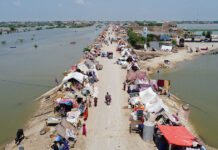Najma Minhas |
Unfortunately, while many of us are fast becoming immune to weekly media headlines of India and Pakistan’s latest never-ending drama with India on the Indus water treaty, donor agencies are continuously publishing reports warning that we are very quickly going to be water starved.
While the think tanks of the world discuss ‘water wars’, Pakistani parliamentarians and government agencies are not interested in understanding the implications of what does water scarcity mean nor do they understand the political and economic consequences this will have. A new donor report helps us to understand the origins of this insensitivity.
Last week, the United Nations Development Program issued its quarterly report titled “Development Advocate Pakistan” in which it addresses key issues facing Pakistan. The latest report addressed water security and called it Pakistan’s most critical development challenge.
Read more: Pakistan Warns India Over Talk Of Scrapping The Indus Water Treaty
Pakistan’s water availability has gone down dramatically from once being a water-abundant country to now experiencing water stress. UNDP statistics show that between 1990 and 2015, per capita water availability declined from 2,172 cubic metres per inhabitant, to 1,306 cubic metres per inhabitant.
The report has also identified how the feudal structure in Pakistan is now being perpetuated through this water scarcity and exacerbating economic inequality in the rural areas of the country. In an outreach program to disseminate the findings of the report, former chairman of the Water and Power Development Authority (Wapda), Shamsul Mulk highlighted an often ignored fact that not only does Pakistan not have a sustainable water policy but more significantly the water that exists is mostly used by landlords in a most inequitable distribution and the poor are deprived of their share.
read more: Misery of the cotton pickers of Sindh demands Bilawal Bhutto’s attention
Pakistan’s water availability has gone down dramatically from once being a water-abundant country to now experiencing water stress.
Many of these landlords are sitting in Parliament and act like ‘absentee landlords’ of water in Pakistan, he said. “Because of this absentee landlordism, water has become the property of the landlords and the poor are deprived of their share’’. This actually gives a strange play to understanding why many parliamentarians are just not interested in dealing with the water crisis. It helps them to stay economically and politically powerful in the regions where they hail from.
“The worst example of landlordism is in Sindh. In Khyber Pakhtunkhwa, the Pushtoon society is a lot more egalitarian. In general, landlords don’t want the poor to become economically self-sufficient to remain in power. So, this water issue is very political in nature,” he said.
Understanding why these parliamentarians are not interested in conserving water also helps to understand why the discussion revolving around Kalabagh dam is a political hot potato and no Pakistani government wants to address it.
A casual observer or a new comer to this scene, is surprised that since the commissioning of the Mangla and Tarbela dams in the 1960s and 1970s respectively, Pakistan has not developed any major water storage infrastructure. During this period, India, the upper riparian in the Indus water system has worked diligently on hundreds of small and large dams and is still expanding its hold through newer structures.
A casual observer or a new comer to this scene, is surprised that since the commissioning of the Mangla and Tarbela dams in the 1960s and 1970s respectively, Pakistan has not developed any major water storage infrastructure.
Consequently, water storage capacity has often receded to less than 30 days against the minimum requirement of 120 days. Despite this, it has not become an issue for Pakistan’s mostly feudal origin elite. This class has neither been able to develop any consensus around major dams – like Kalabagh – or show genuine motivation for other water reservoirs.
The understanding of the problems of lack of water storage Pakistan faces has to be recognized and resolved by the Pakistan government and not held subject to the political blackmailing of a class that is not interested in achieving laudable goals such as the ‘Sustainable Development Goals (SDGs)’ that the government has affirmed that it would work towards.
Read more:World Bank backs out of arbitration on Indus Water Treaty: Implications…
The Sustainable Development Goals, has placed an emphasis on ensuring availability and sustainable management of water for all, this includes achieving universal and equitable access to safe and affordable drinking water, sanitation and hygiene. Currently, over 27 million Pakistanis do not have access to safe water and 53 million do not have access to adequate sanitation facilities.
Not only does Pakistan not have a sustainable water policy but more significantly the water that exists is used by landlords and the poor are deprived of their share.
The repercussions on health alone are severe with an approximate 39,000 children under five die every year from diarrhoea caused by unsafe water and poor sanitation. Furthermore, with the increasing burden on water resources, threats will increase to Pakistanis’ well-being from unsafe or inadequate water supplies.
Working on the Indus water treaty is very important as is working on a treaty with Afghanistan to ensure a continued and stable supply of water in Pakistan. But along with this it is necessary for the government to work on creating water reservoirs, equitable water supply and managing better use of existing water supplies.
Najma Minhas is an analyst and Director of Governance & Policy Advisors. Her email address is: np@gapa.com.pk and tweets @MinhasNajma




